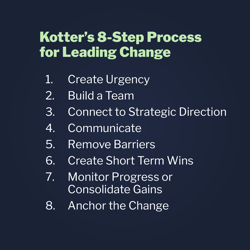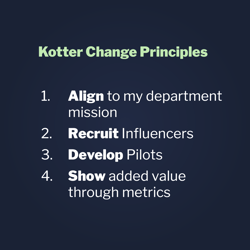Many times, security leaders recognize that if we are not to deliver on our mission, something in our operation needs to change. At the same time, we will likely be confronted with challenges that stand in the way of affecting that change.
Some of the more common challenges that we face in healthcare are competition for resources, resistance by those who may not believe change is needed, or simply the inertia that comes from recognizing that change takes effort.
Throughout the course of my career, I have confronted each of these challenges, both singularly, as well as cooperatively. I write on this topic from the perspective of a four-year client and customer of Vistelar, and as the current chair of their Advisory Board. One led to the other.
My immense success with the Vistelar training program in the last years of my tenure in the healthcare space led to me assisting with their success. This stems from my belief that their conflict management training program is the best that I have seen. Throughout the country, workplace violence in healthcare is a significant issue and in need of high-quality training in the area of conflict management.
A Proven Process
Over the years, I have used various change models to overcome organizational resistance to change. The one that I have found to be the most effective is Kotter’s 8- Step Process for Leading Change. A brief explanation of each step follows:
that I have found to be the most effective is Kotter’s 8- Step Process for Leading Change. A brief explanation of each step follows:
- Create Urgency. With urgency we need to demonstrate that the status quo is no longer viable and there is risk to staying the course. This may be most evident in examples of “near misses” or actual security events that were tragic or costly. We may encounter a situation that cannot be allowed to happen again, and we need to identify what must change to prevent the recurrence.
- Build a team. This is accomplished by identifying effective change leaders and building a coalition. The greater the change being sought, the broader and larger the team might be. Members of the team may come from your department or may include members from other departments too.
- Connect to strategic direction. The goal is to connect the desired change to a previously established organizational strategic goal. Do this by identifying ways in which the change goal(s) supports the strategic goal.
- Communicate. Anyone who will be required to participate in implementing the change, who will be impacted by it, or who perceive that they will be impacted by it, need to understand the what and the why of the change. This will need to be communicated clearly and consistently from the top down. They need to know how it will benefit the organization, and perhaps more importantly, understand how it will benefit them.
- Remove barriers. There are many potential barriers to affecting change. They may come in the form of processes (such as hiring, or the need for additional approvals or permits), resources (such as funding or available equipment) or people (such as the total number of staff/capacity or ability). It is important to remove, or at the very least, reduce each barrier.
- Create short term wins. This step is crucial. By demonstrating that the change is producing measurable and positive results, several things happen. For example, once the change goal becomes credible, naysayers will become less vocal. The combination of those two factors can build a critical mass of acceptance- further improving momentum. After all, who wants to be left behind when they see other people succeeding?
- Monitor Progress or Consolidate gains. Whichever term is applied, the bottom line is that both the positive and negative results should be constantly identified and addressed. Here we ask,” How do we leverage the win and build upon it?” or, “What have we learned from the expected or unexpected setbacks, and how do we adjust?”
- Anchor the change. As the change matures it needs to become the “new norm.” Communicate the success through stories and presentations to reduce the erosion of momentum and possible slippage towards “the good old” ways. Effective communication also helps cement in their minds that change can work, which should also make the next go-around a little bit easier.
Advantages of this change model include that it provides a step-by-step process that can be followed relatively easily. The success of this model largely hinges on how effectively leaders and employees on all levels embrace it. The change is effective because it does not come from a decree, a new policy, or the boss saying, “Do it because I said so.” Rather, it comes from organizational collaboration, by creating buy-in and therefore, less resistance. Lastly, the emphasis on collaboration helps to develop champions of the change organically, potentially reducing the time needed to complete the change process.
However, there is no perfect “one size fits all” change model. This, like other models, has challenges. First, as a step-by-step model, it requires that all steps be employed. Skipping steps could result in delays and problems. Being a somewhat linear process does not mean that each step needs to be completed before the next begins.
In my experience, it is most effective when the steps have some natural overlap, like you can visualize using a Gantt Chart. Be mindful too, that it may be necessary to return to an earlier step when actions or processes in the current step are faltering and in need of a new jump start. Hopefully, this won’t happen often or the delay will contribute to another disadvantage: the length of time needed to complete the change. Individuals who bought-in initially may lose patience or become frustrated. Ongoing communication is critical, as the entire process unfolds.
The Approaches
There are four approaches that I have found useful in fostering change. I have employed these in support of the model discussed above when I have sought change over the years. Some have been large changes; some have been considerably smaller in scope, and some have been within my own department, while others were implemented organization wide. My large-scale projects included departments or stakeholders that were significantly impacted, while others were on the periphery of impact.
I have applied these approaches across a wide range of oversight including, but not limited to, staffing models, new technology, changes in services proved, and a significant change to the conflict management training for security and non-security personnel.
Faced with the ever-increasing challenge of violence being perpetrated against staff and patients and witnessing unsuccessful attempts by my staff to safely and effectively intervene, I looked for alternatives to our training program in this area. My goal was to “up our game” and find processes and training that could lead to that safer and more effective outcome.
Once I found the program that I believed would get us there, I began employing my approaches in support of the Kotter change principles.
- Align to my department mission. The element of our mission, “to create a safe environment for patients, staff, and visitors,” seemed to fit. Initially, this training program was to be taught to security personnel only, and I needed to go no further with our relationship than with that connection. The staff of over 200, including line level officers and management, many who had been there a long time, did not universally embrace the idea of change. I kept hearing, “Why change a good thing?” and “If it’s not broken, don’t fix it,” as the discussion of change began. To address this, regular discussions were held in group settings, in addition to the distribution of my department newsletters. The newsletters were used to remind everyone of our mission, and that changing circumstances and increasing violence were real, and requiring us to change in order to meet our stated mission. Here the communication element was fundamental. The foundation of “the why” was set.
After success within the department and following a decision to move this training beyond the security staff, the same arguments were made relative to the organizational mission of providing safe care for all patients and our commitment to create and maintain a safe workplace.
Like our more recent experiences with security personnel, the violence against patients and staff through all types of violence was all too well known. Statistics were gathered and presented as evidence that we were no longer meeting our mission in this area.
- Recruit influencers. It is important to realize that change requires more than one person. Within the department, I knew which staff were supportive, which were not, and who fell into the middle ground majority. The first step was to establish the importance of training to the members of the security department. Next, was to establish the importance of this training. This was accomplished by moving the training responsibility from the director of operations to a newly created position of training director. Moving the responsibility for training from an over-stretched director of operations to this newly created directorship created two influencing factors. One, it created the opportunity to build out a training program. Changing some officers to trainers, led by a highly respected officer appointed as coordinator, created additional influencers. Officers were selected for the first wave training. Some were in each category of supportive or resistive to the idea. Virtually everyone who attended the training was impressed with it, and those who were still on the fence were quickly becoming the minority.
As the program goal grew beyond security staff, we sought influencers from other departments. Not surprising, those department and site leaders whose staff experienced higher incidents of violence were the first to embrace the program and become influencers.
Not surprising, those were the Behavioral Health and the Emergency Departments. Like the security department experience, some of the leaders totally bought into the effectiveness of the training almost immediately. This was based on observable results. First observed was a reduction in the number of physical incidents as the non-escalation and de-escalation training rolled out. Combined with the underpinnings in the belief in dignity and respect, which is at the foundation of nursing practice and patient care. This created new influencers and real momentum was building.
- Development of pilots. A most important influencer/ally was yet to be fully recognized, our Chief Nurse Executive. In the early stages of the training roll out, a new CNE came on board. She quickly learned that violence in the nursing units was a large issue with the staff. Through discussion we formed an understanding that we had the same goal—to reduce violence. We formed a chartered workplace violence prevention program that also ended up being a group influencer. She became one of the most influential partners in moving the training program forward through the entire organization.
- Showing value added through metrics. The final of the four approaches is establishing metrics to support the value of the change. As the change shifted from training just the security staff to a progressively larger employee population, so did the cost to deliver it. We had to consider not only the cost of the training and the materials needed to do so, but also in finding the staffing resources needed to have other members out of the department to attend training. This can be especially challenging in a highly regulated and credential-based industry, which requires a high level of training already. We were competing with departments, such as diagnostics, whose equipment can cost millions of dollars so acquiring funding was difficult.
Some creativity is needed to show the Return on Investment for training. Showing the value added from a “soft” training program is difficult. You will need to identify and compare diagnostics, and it isn’t always as simple as showing that X number of procedures billed at Y dollars will pay for this machine in 2.5 years. In this situation, research was done in several areas that demonstrated, not a payback of income corresponding to the training, but cost avoidance if it were to be employed. Nurses were fed up with daily violence. Some were retiring early or threatening to leave. By determining the cost of $70,000 from start to finish, to hire a nurse , we could show cost avoidance of $350,000 a year by simply preventing the turnover of 5 five nurses. This was not that large of a challenge given that there’s a nursing population of thousands. With that, we had a hard metric. There was money within the nursing budget that would easily support staff attending some level of this training. An additional metric was related to the cost of worker’s compensation claims due to workplace violence. This included both the costs to treat injuries and the lost time associated with the incident. Overall worker’s compensation costs for a large organization can and do run into the millions of dollars annually. By culling out those dollars associated with workplace violence and, like identifying nurse recruiting costs, another metric was developed that showed a percentage of these savings would help pay for the training.
Identifying metrics required a sound analysis of the organization’s cost and a reasonable, yet firm, commitment to a metric of reducing X number of workers compensation costs and reducing X number of nursing losses through the implementation of the training.
Summary
In summary, we have broadly covered an organizational change process by using Kotter’s 8-Step Process for Leading Change, combined with some specific approaches that I have used regularly in affecting change. Specifically, this was in identifying the need for and implementing a new training program.
To demonstrate how change can grow, in the last four years of my time in this organization- we moved from just changing the training for security staff, to providing a version of this training to over 50% of all staff; that’s roughly 17,000 people!








